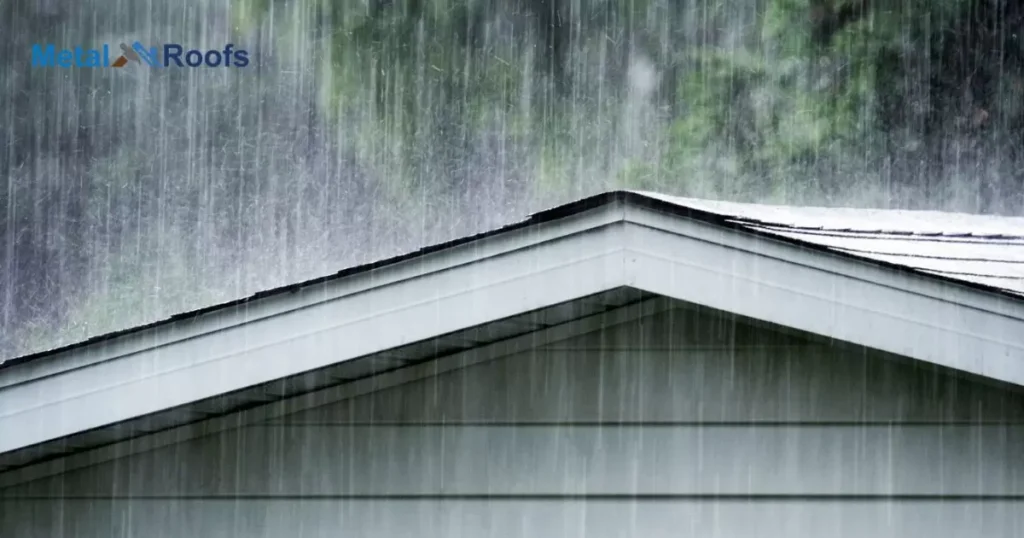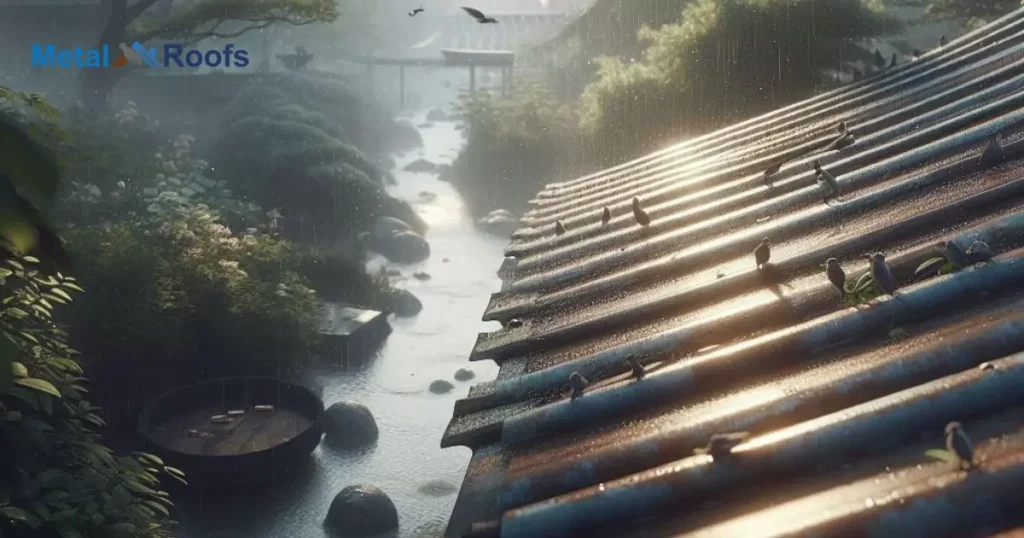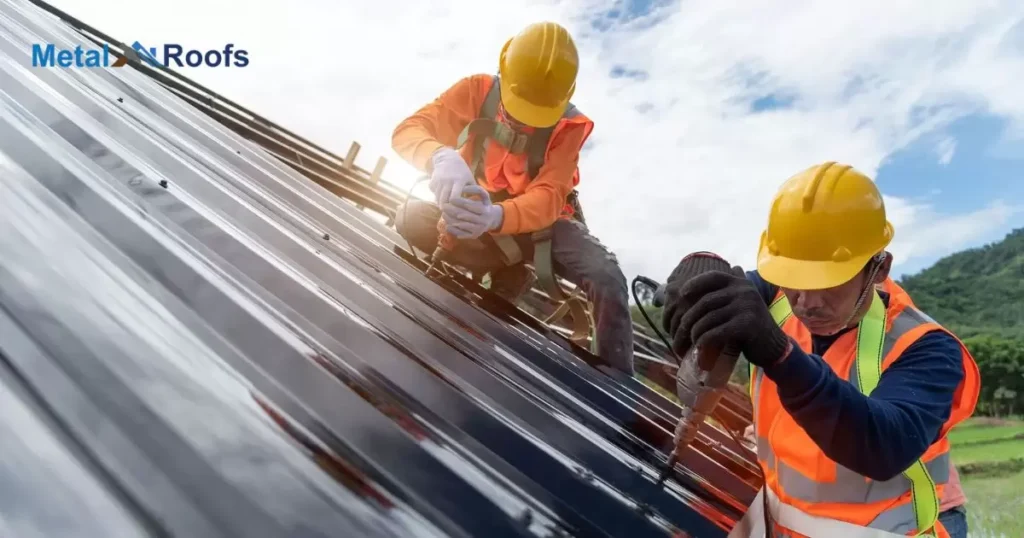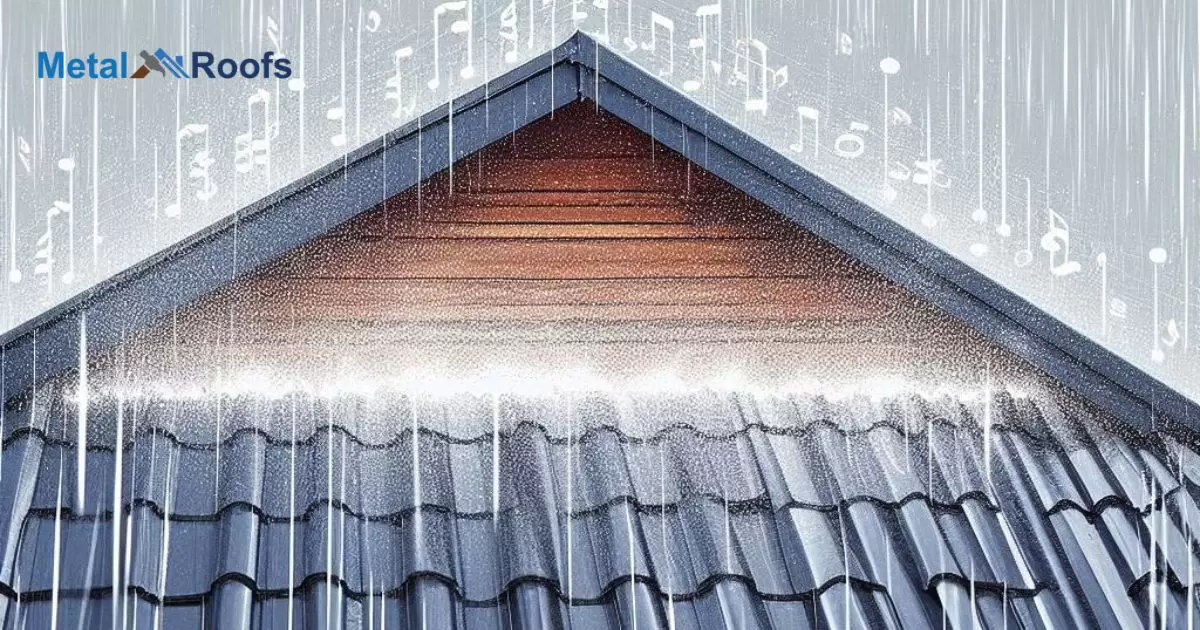Metal roofs can be noisy when rain or hail hits them because the metal material amplifies the sound; insulation under the roof helps dampen noises but shifting metal expanding in heat or wind can also create squeaks or loud banging that may require repairs to eliminate.
Metal roofs can be practical options for homes but also have downsides. Do metal roofs make noise? The metal material can amplify sounds of rain, hail and wildlife hitting the surface. Shifting and creaking from temperature changes are also common complaints about metal roof noise.
Rain or hail on the metal surface gets amplified. Temperature shifts cause expansion and contraction noises too. Insulation under the roof helps dampen sound. Understanding common metal roof noises will set proper expectations.
Key Takeaways
- Metal roofs can produce noise, but proper installation and insulation reduce it.
- Factors like type of metal, underlayment, and environmental conditions impact noise levels.
- Regular maintenance prevents issues like loose panels that contribute to noise.
- Noise from rain or hail can vary, but many find it manageable or even soothing.
- Choosing materials designed for noise reduction enhances overall comfort under a metal roof.
What Causes Noise In Metal Roofing?
Metal roofing can produce noise due to various factors. The type of metal used plays a role, as some metals resonate more than others. Improper installation can lead to panels vibrating in the wind, causing noise.
Environmental conditions like rain and hail can also contribute to the noise. Raindrops hitting the metal surface create sound, and the intensity of the rain affects the volume. Similarly, hail striking the metal trim around a roof can produce loud noises.
Impact Of Metal Roofing On Noise Levels

Metal roofs can make noise, but it depends on factors like metal type and installation. Properly installed metal roofs with insulation underneath tend to reduce noise levels.
Rain and hail can cause noise, but some find the sound soothing. With care in installation and choice of materials, noise from metal roofs can be minimized for homeowners’ comfort.
Metal Roofs Compare To Other Roofing Materials In Terms Of Noise
Metal roofs can produce noise, but it’s influenced by factors like metal type and installation. Different metals have varied acoustic properties, impacting noise levels. Proper installation and insulation can dampen noise, making it comparable to other materials.
Materials like asphalt shingles can also generate noise, particularly during heavy rain. While metal roofs may sound louder than some materials, they can offer similar noise levels with proper insulation. Overall, noise levels between metal roofs and other materials can be comparable with the right installation and considerations.
Minimizing Noise From Metal Roofing
Metal roofs can sometimes create noise, but there are ways to minimize it. Proper installation is crucial. Ensure panels are securely fastened to prevent rattling in windy conditions.
Adding insulation and underlayment beneath the metal roof can absorb sound waves and reduce noise. Choose materials that are designed to dampen sound effectively. With the right measures in place, metal roofs can be quiet and comfortable in any weather.
Can Attic Insulation Help Reduce Noise From Metal Roofing?
Yes, attic insulation can help reduce noise from metal roofing. Insulation absorbs sound waves, dampening noise. Thicker insulation provides better noise reduction.
Choosing dense insulation materials can further minimize noise. Overall, proper attic insulation can significantly decrease the amount of noise transmitted through a metal roof, creating a quieter indoor environment.
Effective Ways To Soundproof A Metal Roof
Insulation: Install high-quality insulation materials between the metal roof and the interior ceiling. Opt for dense materials like fiberglass or mineral wool, which effectively absorb sound vibrations and reduce noise transmission.
Mass-Loaded Vinyl (MLV): Layer mass-loaded vinyl (MLV) on top of the insulation to add an extra barrier against noise. MLV is a dense, flexible material that blocks sound waves, helping to minimize the impact of noise from rain, hail, or other sources on the metal roof.
Seal Air Gaps: Thoroughly seal any gaps, cracks, or openings in the roof structure where sound could travel through. Use caulking or foam sealant to seal gaps around vents, chimneys, and edges to prevent noise from entering or escaping.
Acoustic Underlayment: Install specialized acoustic underlayment beneath the metal roofing material. These underlayments, made from materials like rubber or cork, absorb sound vibrations and reduce noise transmission into the interior space.
Damping Materials: Apply damping materials directly to the metal roof panels to reduce noise. Viscoelastic compounds or soundproofing sprays can be used to dampen vibrations and convert sound energy into minimal heat, effectively decreasing noise levels inside the building.
Implementing these strategies in combination can significantly improve the soundproofing of a metal roof, creating a quieter and more comfortable indoor environment.
Metal Roof Sound Dampening

Metal roofs can make noise, especially during rain or hail. However, several methods can dampen these sounds. One way is by using insulation and underlayment beneath the metal panels. These materials absorb sound waves, reducing noise levels inside the building.
Proper installation techniques can minimize vibrations that cause noise, making the metal roof quieter during windy conditions. Overall, with the right approach, metal roofs can be made significantly quieter, providing a comfortable living environment for homeowners
Factors Affecting The Noise Levels Of Metal Roofing
| Factors | Details |
| Type of Metal | Different metals have varying acoustic properties, impacting the level of noise transmission. |
| Installation Quality | Proper installation techniques are crucial for minimizing vibrations and noise. Improper installation can lead to increased noise levels. |
| Insulation Underneath | Adding insulation beneath the metal roof helps absorb sound waves, reducing noise transmission into the building. |
| Environmental Conditions | Rain intensity, wind speed, and other weather factors can influence noise levels. Raindrops hitting the metal surface and wind gusts can contribute to noise. |
| Maintenance of the Roof | Regular maintenance, such as securing loose panels and repairing damaged insulation, helps prevent noise issues over time. |
Metal roofing noise levels can vary based on several factors. The type of metal used plays a significant role. Proper installation techniques are crucial for minimizing noise. Adding insulation underneath the metal roof can help dampen sound.
Environmental conditions like rain intensity and wind can also influence noise levels. Overall, careful consideration of these factors can help mitigate any potential noise issues associated with metal roofing, ensuring a comfortable living environment for homeowners.
The Science Behind Metal Roofing And Noise Transmission
Metal roofs can indeed produce noise, primarily influenced by factors such as the type of metal used and the installation method. Different metals possess varying acoustic properties, affecting the level of noise transmission. Careful installation plays a crucial role in reducing vibrations that can lead to noise.
Environmental conditions like rain or hail can also impact noise transmission. However, with proper measures in place, such as selecting appropriate materials and ensuring meticulous installation, the noise generated by metal roofing can be minimized to a comfortable level for residents.
Practical Tips For Reducing Noise From Metal Roofing
Install Insulation: Properly insulate the space between the metal roof and the interior ceiling using high-quality materials like fiberglass or mineral wool. Insulation absorbs sound vibrations, reducing noise transmission into the building.
Use Acoustic Underlayment: Install acoustic underlayment beneath the metal roofing material. These specialized underlayments, made from materials like rubber or cork, help absorb sound vibrations and reduce noise levels inside the building.
Seal Air Gaps: Ensure all gaps, cracks, and openings in the roof structure are sealed with caulking or foam sealant to prevent noise from entering or escaping. Pay close attention to areas around vents, chimneys, and edges.
Apply Damping Materials: Apply damping materials directly to the metal roof panels to reduce vibrations and noise transmission. Soundproofing sprays or viscoelastic compounds can be effective in dampening sound.
Consider Roof Design: When possible, opt for roof designs that minimize noise transmission, such as steeper slopes that allow water to drain quickly during rainfall. Additionally, avoid complex roof shapes that may create areas where noise is amplified.
By implementing these practical strategies, you can effectively reduce noise from metal roofing and create a quieter indoor environment.
Metal Roofing Installation And Noise Considerations
Metal roofs might produce noise, but it depends on various factors. The type of metal and how it’s installed influence noise levels. Proper installation can minimize vibration and noise during windy weather.
Adding insulation beneath the metal roof helps reduce noise further. Environmental factors like rain and hail can also cause noise. Despite this, with careful installation and insulation, metal roofs can offer a comfortable living environment.
Metal Roofing Maintenance For Minimizing Noise

To minimize noise from metal roofing, start with proper installation. Ensure panels are securely fastened to prevent vibration. Choose materials designed for noise reduction. Insulate the attic space beneath the roof to absorb sound waves. Regularly inspect and maintain the roof for loose panels or damaged insulation.
Routine upkeep is key to minimizing noise over time. Clean debris from the roof’s surface to prevent buildup. Check for signs of rust or corrosion and treat as needed. Trim overhanging branches to reduce the risk of debris hitting the roof during storms. By staying proactive with maintenance, you can enjoy a quieter living space beneath your metal roof.
Frequently Asked Questions
How do you stop a metal roof from making noise?
Ensure proper installation and insulation underneath to minimize vibrations and absorb sound waves.
What is the biggest problem with metal roofs?
The biggest problem with metal roofs is potential noise during heavy rain or hail. However, proper insulation and installation can mitigate this issue.
Are metal roofs noisy in rain?
Metal roofs can produce some noise during rain, but proper insulation and installation methods can help minimize it.
Conclusion
Metal roofs can make unwanted noises. The rigid material amplifies precipitation and wildlife impacts. Shifting from temperature swings also makes noise. Added insulation helps dampen sound transmission. Understanding causes of metal roof noise will help set
expectations.
Noisy metal roofs may require repairs. Adjusting panels, reinforce framing, add rubber washers, or apply sound deadening pads. Seeking professional assessments of noise causes is recommended. Proper installation and maintenance can reduce unwanted metal roof noises over time. Setting realistic expectations helps homeowners adapt.











